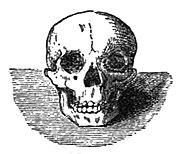In accordance with the fashion of the epoch, a Latin inscription on the wall indicated to the learned passer-by the pious purpose of this cell. The custom was retained until the middle of the sixteenth century of explaining an edifice by a brief device inscribed above the door. Thus, one still reads in France, above the wicket of the prison in the seignorial mansion of Tourville, Sileto et spera; in Ireland, beneath the armorial bearings which surmount the grand door to Fortescue Castle, Forte scutum, salus ducum; in England, over the principal entrance to the hospitable mansion of the Earls Cowper: Tuum est. At that time every edifice was a thought.
As there was no door to the walled cell of the Tour-Roland, these two words had been carved in large Roman capitals over the window,—
TU, ORA.
And this caused the people, whose good sense does not perceive so much refinement in things, and likes to translate Ludoivico Magno by Porte Saint-Denis, to give to this dark, gloomy, damp cavity, the name of "The Rat-Hole. An explanation less sublime, perhaps, than the other; but, on the other hand, more picturesque.

